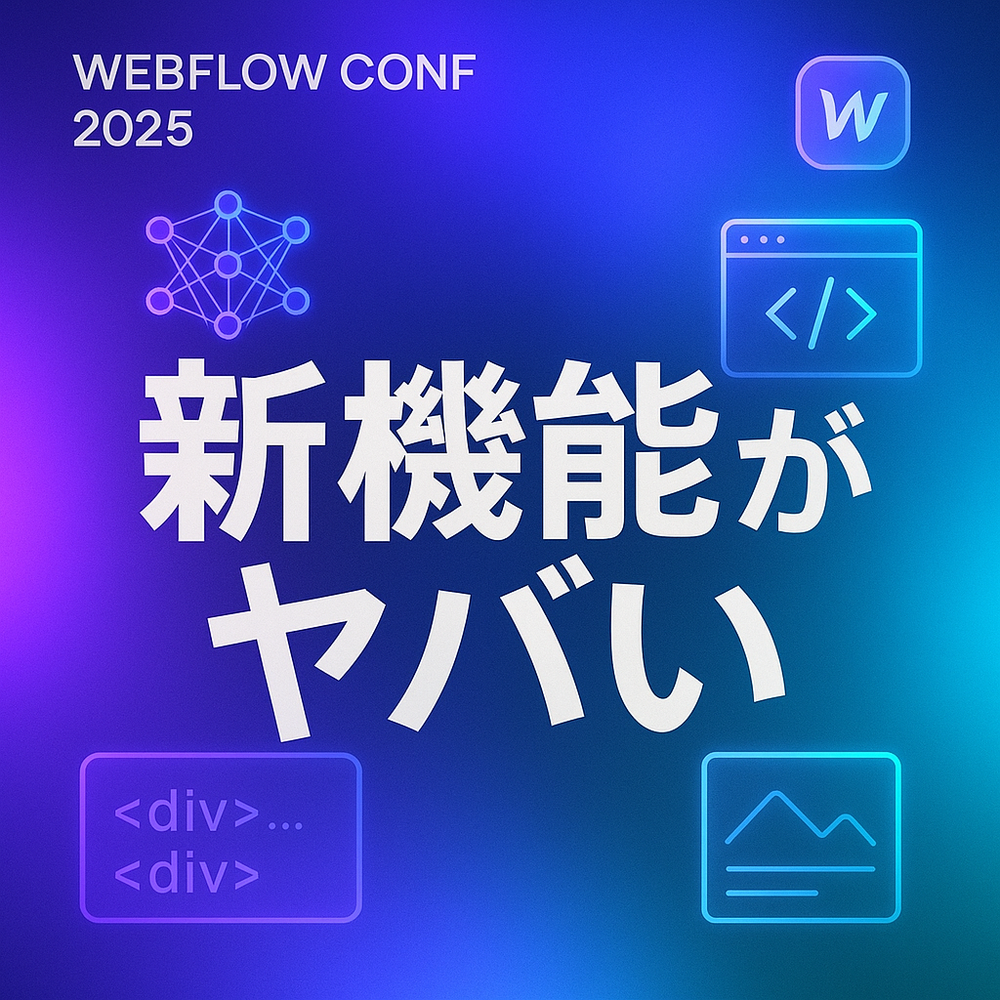Do I need coding with Webflow? Thorough explanation of what can and cannot be done with No Code
I'm considering creating a site with Webflow, and I'm wondering “is coding really unnecessary?” Aren't you wondering? If you read this article, it will become clear how far it can be achieved with Webflow's no-code function, and conversely, specific situations where coding is necessary and advantageous, how to implement custom code, and even advantages and disadvantages. In conclusion, Webflow can create highly functional sites without coding in many cases, but it can be seen that coding knowledge can be a powerful weapon to further expand the range of expression under specific requirements.
1. Does Webflow require no coding? The basic way of thinking
When creating a website using Webflow (webflow), one of the first questions many people have is”Is coding really unnecessary?It probably means”. In conclusion, WebflowIn most cases, it is possible to build a very high quality and highly functional website without writing a single line of code such as HTML, CSS, or JavaScriptIt's a platform. However, on the other hand, there are situations where coding knowledge is useful, and aspects where possibilities are further expanded through coding. In this chapter, I will explain basic ideas about the relationship between Webflow and coding.
1.1 Basic Positioning of Webflow: Combining No-Code and Low-Code
Webflow is commonly introduced as a “no-code (No-Code)” tool. This means that even designers, marketers, or entrepreneurs with no programming knowledgeThrough an intuitive visual interface, you can build a website as if you were using a design toolIt's from there. You can check element placement, styling, interaction settings, etc. in real time while operating directly on the screen.
However, it might be a bit short-sighted to think of Webflow as just a no-code tool. At the same time, Webflow also has a strong aspect as a “low-code (Low-Code)” platform. In other words,While basic parts can be created without writing code, more advanced customizations and functionality extensions are possible by embedding custom code (HTML, CSS, JavaScript) and editing exported code as neededThat's it. thisThe point that it combines the ease of no-code with the flexibility of low codeThis is a major characteristic of Webflow, and it can be said that it is one of the reasons why it is supported by many professionals. Webflow itself explains the power of no-code development. (Reference: What is No-Code? | Webflow)
1.2 Scope of what can be achieved with “no coding required”
So, exactly to what extent can it be achieved without coding? Surprisingly many things are possible. General corporate sites, service sites, portfolio sites, blogs, small to medium EC sites, etc.The functions and designs required for many website production projects can be fully covered by Webflow's standard features alone. Specifically, functions such as realizing a pixel-perfect design, complex layouts, responsive support, managing blog posts and achievements using a CMS (content management system), implementing rich interactions and animations, basic SEO settings, and installing forms can be implemented without coding knowledge. These details will be explained in detail in the next chapter “What you can do with Webflow's no-code features”.
1.3 Easy to get started without coding knowledge
One of Webflow's biggest attractions isEven non-engineers with no coding skills can create professional-level websites with their own handsIt's in the point. In conventional web production, it was common to have a division of labor where engineers perform coding based on design camps created by designers. However, by using Webflow, it is also possible for designers themselves to do everything from design to implementation at once. Thanks to this,You can expect a reduction in communication costs and an increase in production speed. It's also a powerful tool for startups and sole proprietors because ideas can be quickly brought to life without the time or cost of learning to code.
1.4 The viewpoint of “having coding knowledge further expands possibilities”
On the other hand, don't just believe in the phrase “no coding required,”If you have coding knowledge, you can further unlock the potential of WebflowThat point of view is also important. Knowledge of custom code is useful when aiming for very specific requirements, advanced collaboration with external services, and optimization of performance to the extreme that cannot be achieved with Webflow's standard features alone. Also, if you understand the basic structure of HTML and CSS, it will be easier to guess what kind of code the Webflow visual interface internally generates, and you may be able to build a site more efficiently and as intended. In other words,Webflow is powerful enough even if you can't code, but it's an even more powerful tool if you can codeIt would be most accurate to understand it. We'll delve into more detail in later chapters when coding is necessary and advantageous, and how to handle custom code.
2. What can you do with Webflow's no-code feature
Webflow is known as a “no code” or “low code” web production platform, but specifically how far can it be realized without coding? Here, I will explain in detail the range that can be achieved with the no-code functionality provided by Webflow as standard. By understanding these features, you'll be able to clearly separate them from situations where coding is required.
2.1 Creating a site with a high design
One of Webflow's biggest attractions is thatOverwhelming degree of design freedomThat's it. Using the intuitive visual interface “Designer (Designer),” which is as if operating graphic software, you can build designs that are particular about every detail with pixel perfection. You can arrange elements, style, and adjust the layout without knowledge of HTML or CSS.
In particular, to achieve complex layoutsFlexbox and Grid layouts can also be set intuitively with visual controlsYou can do it. As a result, websites with modern and sophisticated designs, where CSS coding was previously essential, can also be created without code. There are plenty of templates available, but it's also easy to create a completely original design from scratch. For more informationWebflow official website (design features)Please see also.
2.2 Responsive design support
In modern website production, smartphones, tablets, etc.Support for various devices is essentialThat's it. Webflow makes it easy to implement responsive design with standard features without coding. You can fine-tune the show/hide, size, arrangement, style, etc. of elements for each pre-prepared breakpoint (desktop, tablet, mobile landscape, mobile vertical orientation).
If you use the preview function,Adjust in real time while checking the actual displaySince it can be done, work can proceed efficiently. There is no need to write media queries directly, and it is a huge advantage that layouts and designs optimized for each device can be realized with only visual operation. More details about responsive support can be found on Webflow's responsive design introduction page.
2.3 Content management using CMS functions
Webflow incorporates powerful CMS (content management system) functionality,Build and operate dynamic websites without codingYou can do it. You can create something like a database called a “collection” and manage various types of content, such as blog posts, introduction of achievements, product information, introduction of team members, etc.
You can define rich field types, such as text, images, rich text, dates, and reference relationships, and display these data anywhere on the site. Once you create a design template,Pages are automatically generated and updated simply by adding content to the CMSAs a result, operational efficiency is greatly improved. It is characterized by the fact that it can be completed within Webflow without the need to install a separate system such as WordPress. What are the details of Webflow CMSCMS introduction page on the official websitePlease see.
2.4 Implementing Interactions and Animations
By adding movement and effects to a website, you can improve the user experience (UX) and make the site more attractive. If you use Webflow's “Interactions (Interactions)” function,Implement rich animations and interactions without JavaScript codingYou can do it.
It is possible to combine various triggers and animation effects, such as element appearance animations, effects in response to scrolling (parallax effects, etc.), changes when mouse-over, and actions when clicking. It's a timeline-based editorDetailed visual adjustments to movement timing and easing (acceleration and deceleration)You can do it. This makes it possible to achieve sophisticated movements that give a professional look to websites without code. For interaction features,Webflow Interactions introduction pageIt is explained in detail in
2.5 Basic SEO settings
Search engine optimization (SEO) is very important when it comes to publishing a website. In Webflow,It comes standard with features to perform basic SEO settings without coding. You can easily input and set title tags (title tags), meta descriptions, OGP settings (display settings when sharing on SNS), and alt attributes of images for each page from the management screen.
Additionally, automatically generating and sending XML sitemaps, setting 301 redirects, editing robots.txt (paid plan), etc.Settings required for search engines to properly recognize and evaluate your sitecan also be done without code. Custom code may be required for more advanced settings, such as structured data markup, but basic SEO measures can be fully covered by WebFlow's standard features. For information on Webflow's SEO features,SEO function introduction page on the official websiteIt is also helpful.
2.6 Form Installation
Forms on the website, such as inquiries, requests for materials, and event applications, are an important point of contact with users. In Webflow,Create and install custom-designed forms with a simple drag-and-drop operationYou can do it. You can freely combine various input fields, such as text input, email addresses, check boxes, radio buttons, drop-down lists, and file uploads.
Notification settings when a form is submitted, redirection to a thank you page after submission, spam countermeasures using Google reCAPTCHA, etc.Configurable without codingThat's it. In addition to being able to check the collected data on the Webflow management screen, it is also possible to automate it by linking with an external tool such as Zapier (restrictions and settings depending on the plan may be necessary for collaboration). What is the basic way to create a formWebflow University Form Introduction (English)You can learn it at
3. Situations where coding is needed/advantageous in Webflow
Webflow is a powerful no-code/low-code platform, but not every website creation request can be met without coding. Under certain circumstances,Coding knowledge such as HTML, CSS, and JavaScript becomes essential, and can be of great help in advancing projects advantageously. Here, I will explain in detail specific situations where coding is necessary or advantageous in Webflow.
3.1 Implementing more advanced custom features
It cannot be realized with only Webflow's standard functions or built-in collaboration functions,If you want to implement advanced functionality or complex logic based on your own requirements, custom coding is required. Customization beyond the scope of no code is made possible through coding. In order to achieve detailed behavior control and deep collaboration with external systems, which cannot be reached with Webflow's visual editor alone, the power of code is required.
3.1.1 Complex collaboration with external services
Webflow supports basic service integration via Zapier, etc., but moreCooperation requiring real-time performance, two-way data synchronization, and API collaboration requiring special authentication methodsDevelopment using custom code (mainly JavaScript) is necessary in order to meet complex requirements such as For example, the following cases can be considered.
- Specific user actions (e.g., button clicks, form submission) are triggered, and data is sent to an external CRM (customer management system) or MA (marketing automation) tool in real time, and customer information is immediately updated.
- It links with external databases (e.g., via Airtable, Google Sheets API, etc.) to realize dynamic content filtering and search functions that exceed Webflow CMS limitations.
- It directly links with payment systems such as Stripe and PayPal, and constructs unique payment flows and complex subscription models that cannot be handled by the Webflow e-commerce function.
- API links are performed with core systems and inventory management systems, and the latest inventory status is always displayed on the website.
- Implement a login function linked to an external authentication platform (example: Auth0, etc.) on membership-based sites, etc.
To implement these, it is essential to have the skills to decipher the API documents of the target external service, send HTTP requests using JavaScript, and properly process received responses (JSON format, etc.). Webflow itself also provides a REST API, and by utilizing this, it is also possible to programmatically manipulate Webflow functions from outside. For detailsWebflow DevelopersYou can check it out in the official documentation.
3.1.2 Custom JavaScript animations
Webflow is equipped with an “interaction” function as standard, and it is possible to implement scrolling linkage and animations when clicking without code. However,Complex movements that require extremely elaborate effects, advanced animations using specific JavaScript libraries (e.g. GSAP: GreenSock Animation Platform), and performanceIf you want to implement it, custom coding is required. Specifically, the following examples can be mentioned.
- A storytelling-like production where multiple elements move in conjunction along a complex timeline according to the scroll position.
- An expression in which the background is distorted and interactive effects occur as the mouse cursor moves.
- An animation in which lines are drawn along the path of an illustration drawn with SVG (Scalable Vector Graphics), and shapes are smoothly transformed (morphed).
- An interactive expression where objects fall due to gravity or collide with each other by combining physical calculation engines (Matter.js, etc.).
- Use WebGL (Three.js, etc.) to express interactive 3D objects and spaces within a website.
- Computation-intensive visual effects, such as particle expressions and fluid-like expressions.
These advanced animations and interactions are difficult or impossible to create using Webflow's standard features alone. JavaScript and related libraries (in particular, it is the de facto standard for animation librariesGSAPIf you have knowledge about (etc.), you can dramatically improve the expressive power of a website.
3.1.3 Handling special data structures
Webflow CMS (content management system) is extremely flexible and powerful,Data with complex relationships such as relational databases, deeply nested JSON data, and special data structures such as graph structuresIf you want to handle it, you may reach the limit with just the standard features. For example, the following is the case.
- A dashboard function that aggregates and displays personalized information for each user.
- Data with a hierarchical structure acquired from an external API is visualized as an interactive tree display or chart on the Webflow site.
- Content is dynamically filtered and displayed based on complex relationships (many-to-many, etc.) between multiple CMS collections.
- Handle geospatial information (GeoJSON, etc.) and plot data on an interactive map.
In such cases, it is necessary to process and format data obtained from an external API using JavaScript on the client side, combine data obtained from Webflow CMS, convert it to the target format, and then display it. Programming skills to understand the structure of data and manipulate it are required.
3.2 Repurpose and fine-tune existing code
If you have code assets (specific UI components, useful JavaScript utility functions, etc.) for websites developed in full scratch or other CMS (like WordPress) in the past,I want to reuse them in my Webflow projectThinking about it is an efficient approach. With Webflow, you can incorporate existing HTML, CSS, and JavaScript code into your site by using the custom code embedding function (Embed component) and the ability to add code to page headers/footers.
Also, for designs and functions created with Webflow's visual editor,I want to subtly change only the style of specific elements, or I want to add CSS rules that only apply to specific devices or browsers, and I want to fine-tune the behavior of specific interactions with JavaScriptThere is also a need for this. In such cases, if you have knowledge about CSS cascading (level of detail) or JavaScript DOM manipulation, you can make pinpoint corrections and add features. However, custom code that relies too much on class names and structures automatically generated by Webflow may also be affected by updates on the Webflow side, so careful implementation is necessary.
3.3 Extreme Performance Optimization
Webflow can build sites that demonstrate high performance even under standard conditions by generating clean code, utilizing CDN (content delivery networks), and automatically optimizing images. However,Large-scale sites or when extremely high performance requirements (e.g., improved conversion rates on EC sites, improved SEO evaluations on media sites) are required, in order to improve display speed in milliseconds and achieve high scores in all Core Web Vitals indicatorsSometimes, in-depth optimization through coding is necessary.
Specifically, the following advanced tunings can be considered.
- More detailed control and custom implementation of lazy loading (lazy loading) strategies for resources such as images and iframes.
- Analyze critical rendering paths and optimize JavaScript and CSS loading methods (asynchronous loading, lazy loading, etc.) that block rendering.
- Loading control to minimize the impact of third-party scripts (ads, access analysis tools, etc.).
- Optimize how web fonts are read and prevent delays in text display (FOIT/FOUT).
- Use the code export function to manually delete unnecessary CSS rules (purgeCSS, etc.), bundle and compress JavaScript (Minify), etc. on the exported code.
These optimization tasks presuppose a deep understanding of browser rendering processes and network communication, and coding skills in HTML, CSS, and JavaScript. The ability to decipher the results of performance measurement tools (Lighthouse, PageSpeed Insights, etc.) and implement specific improvement measures at the code level is required. Information on performance indicators is provided by Googleweb.devetc. are reliable sources of information.
3.4 Why coding knowledge in Webflow is useful
Even if you don't plan to do custom coding directly in the Webflow project,Having basic knowledge of HTML, CSS, and JavaScript is a huge advantage in understanding the tool called Webflow more deeply, maximizing its potential, and using it efficientlyIt will be. Webflow is just a visual development environment based on standard web technology (HTML, CSS, JS), so understanding the underlying mechanism is useful in various situations.
- Improved problem solving skills (troubleshooting): When a problem occurs, such as the design not being displayed as intended or the interaction not working as expected, you can quickly identify the cause by opening the browser's developer tool (inspector) and checking the structure of the HTML elements, applied CSS rules, JavaScript error messages output to the console, etc., and obtain hints for making appropriate corrections on the Webflow editor.
- Improved design repeatability and maintainability: By understanding how WebFlow generates HTML elements and assigns class names, it is possible to design with a more semantic (semantic) and clean HTML structure in mind. This makes it easier to maintain later and collaborate with other developers. Knowledge of CSS design methods such as BEM (Block, Element, Modifier) can also help manage class name naming conventions in a more systematic manner.
- A precise understanding of the limitations and possibilities of no-code functionality: If you have coding knowledge, you can make decisions such as “this can be achieved with Webflow's standard features,” “this seems to require custom code,” and “this function is technically difficult” more accurately in the early stages of the project. This makes it possible to prevent unrealistic requests and suggest alternatives, so the project can proceed smoothly.
- Decide and implement the right custom code implementation: When custom code is needed, it is possible to accurately make technical decisions such as what part, what kind of code (HTML, CSS, JS) is most efficient to embed, and how interference with existing Webflow functions can be minimized.
- Integrate with other developers and tools: When exporting code from a site created with Webflow and using it in other environments, or conversely, incorporating code created externally into Webflow, cooperation progresses smoothly if there is understanding at the code level.
In conclusion, coding skills areThe key to using Webflow not only as a “no-code tool,” but also to making the most of it as a “professional web development platform”It makes it possible to build more complex, sophisticated, and high-performance websites.
4. How to do custom coding in Webflow
Webflow is extremely powerful as a no-code/low-code tool, but there are situations where writing custom code is necessary to meet specific requirements. Fortunately, Webflow provides several features to flexibly add and manage custom code. Here, I will specifically explain the main methods for custom coding in Webflow.
4.1 Custom Code Embed Function (Embed)
One of the easiest ways to add custom code to Webflow is to use the “Embed” component. This can be placed anywhere on the page by dragging and dropping from the Webflow Designer's “Add Elements” panel (shortcut key: A).
When the Embed component is placed, a dedicated code editor is displayed, and HTML, CSS (`
- Paste the embed code for a specific third-party widget (e.g. event calendar, reservation form, etc.).
- Apply special CSS styling for only a portion, which is difficult with only Webflow's standard features.
- Add simple JavaScript interactions specific to that element.
However, code written within an Embed component is output directly to the location where that component is placed. Therefore, code that affects the entire site or may be unsuitable for writing large amounts of code. Also, keep in mind that code management is easy to distribute. For usage and details, it's a good idea to also refer to Webflow University's documentation on custom code.
4.2 Adding code to headers/footers
If you want to apply common custom code to the entire site or to specific pages, adding code from Site Settings (Site Settings) or Page Settings (Page Settings) is a good option. This results in HTML`
in `tags, or`
5. Advantages and Disadvantages of Coding with Webflow
Webflow is extremely powerful as a no-code/low-code tool, but incorporating custom coding can unlock even more possibilities. However, there are not only advantages but also disadvantages. Here, I will explain in detail the advantages and precautions when coding with Webflow.
5.1 Advantages The degree of freedom in design has been greatly improved
It is possible to create a website with a very high design even with only the standard functions of Webflow, but by using coding,Unique design expressions that are difficult or impossible to achieve with standard functions alone are possibleIt will be. Examples include complex animations using specific JavaScript libraries, detailed styling that makes full use of CSS pseudo-elements and advanced selectors, and implementation of SVG animations. This makes it easier to more faithfully reflect your brand image and differentiate yourself from competitor sites. Pixel-perfect design adjustments can also be made with greater precision if you have coding knowledge.
5.2 Benefits Expanding the possibilities for function extensions
Webflow has CMS functions, e-commerce functions, etc., but moreIf you want to achieve complex functions or advanced collaboration with external services, coding is an effective methodIt will be. For example, it is possible to link with a unique database using an external API, incorporate a special payment system, and link more deeply with MA (marketing automation) tools and CRM (customer relationship management) tools. Also, using JavaScript, it is also possible to implement dynamic content display in response to user input, interactive elements like games, and complex form validation. This can greatly increase the value offered by the website.
5.3 Advantages Leveraging existing skills (HTML/CSS/JS)
For those who already have front-end development skills such as HTML, CSS, and JavaScript, WebflowA powerful tool that can streamline the design process and basic site construction while utilizing that knowledgeIt could be. A hybrid development style is possible, where basic frameworks and designs are created using Webflow's visual interface, and then complementing details and features that can only be achieved through coding. This makes it possible to increase development speed compared to coding from scratch while ensuring a degree of freedom that exceeds the restrictions of no code. It's also easy to reuse existing code snippets and libraries.
5.4 Disadvantages There is a possibility that some of Webflow's usability will be impaired
If you use custom coding a lot,There is a possibility that some of Webflow's original strengths, “intuitive operability” and “visual ease of understanding” will be impairedThere is. The place where the code is embedded is displayed as a simple “custom code block” on the Webflow designer screen, making it difficult to visually grasp and edit its content and behavior. As a result, there is a risk that misunderstandings will occur or that correction work will depend on a specific person in charge, especially when collaborating with designers or clients without coding knowledge. There is no denying the aspect that no-code ease of use is lost, and the development process becomes more complicated.
5.5 Disadvantages Coding knowledge is required
Naturally, in order to do custom coding,Knowledge of HTML, CSS, and often JavaScript is essentialThat's it. Writing, debugging, and maintaining custom code is difficult if you're just used to Webflow's no-code features. In particular, dynamic function implementation and API collaboration using JavaScript require reasonable learning costs. Since specialized skills are also required to identify the cause and fix errors when they occur, this is a major hurdle for people with no coding experience. Webflow's official documentation explains basic usage of custom codes, but self-study is required for further applications. References: Webflow University - Custom Code in the Designer
5.6 Disadvantages Risk of reduced maintainability
Implementing custom code meansRisks that reduce website maintainabilityIt is accompanied by If the written code is complicated or there is a lack of documentation, it may take time to understand the intention of the code or cause unexpected bugs (degrades) when making corrections or adding features later. Also, Webflow regularly updates its platform, andUpdates may cause custom code to not work as intendedIt's also not zero. “Personalization,” where the code depends on a specific person in charge, is also likely to occur, and there are also cases where it becomes difficult to take over when the person in charge changes. Measures such as writing appropriate comments, version control, and formulating common rules are necessary.
6. Comparing Webflow with other web production methods from a coding perspective
Webflow has established a unique position as a no-code/low-code development platform, but what differences are there in terms of coding when compared to other website creation methods? Here, we compare WordPress, which is a typical method, other no-code tools (STUDIO, etc.), and full-scratch coding, and clarify the characteristics of each and the positioning of Webflow.
6.1 Comparison with WordPress
WordPress is the most used CMS (content management system) in the world, and by using themes and plugins, you can build a website even if you have little coding knowledge. However,If you want to make detailed design adjustments or add unique features, coding knowledge such as PHP, CSS, and JavaScript is almost essentialIt will be. In particular, customizing theme files and developing plug-ins requires understanding the functions and rules (WordPress loops, hooks, etc.) unique to WordPress.
Webflow, on the other hand, allows intuitive design construction on a visual interface, and no coding is required for basic functions. If you use the custom code function, you can add HTML, CSS, and JavaScript,Even if you don't have server-side language (PHP) knowledge like WordPress, you can do a lot of customizations with just front-end knowledgeThat's a big difference. You can check information on WordPress theme development in Theme Development - WordPress Codex Japanese version, etc.
In terms of freedom of coding, WordPress can be customized at the PHP level, so it may be advantageous for implementing complex functions, including server-side processing. However, in terms of design freedom and front-end interaction implementation, Webflow can often be performed more intuitively and efficiently. From the viewpoint of maintainability, managing updates for plugins, themes, and main units is important for WordPress, but since Webflow is integrated with hosting, the Webflow side performs basic platform maintenance. However,You are responsible for maintaining any custom code you addIt will be.
6.2 Comparison with other no-code tools (STUDIO, etc.)
Domestic no-code tools such as STUDIO are also common with Webflow in that they can create highly designed websites without coding. However, there is a huge difference from a coding perspective. Many no-code tools areThe ability to embed custom code is limited or not providedThere are cases. For example, STUDIO offers the ability to embed HTML, CSS, and JavaScript code in specific plans, but it doesn't have as much freedom as Webflow (see Custom Code Embedding - STUDIO U for details).
While Webflow is easy to use as a no-code tool,Aspects as a “low code” platform that can flexibly add and edit HTML, CSS, and JavaScript as neededIt can be said that it is stronger. This increases scalability when implementing complex interactions beyond the scope of no code, collaboration with external APIs, and special data processing. Regarding the degree of freedom in design, Webflow can also set CSS properties in detail, so it may be advantageous for pixel-perfect design reproduction and implementation of more advanced animations. On the other hand, tools like STUDIO have advantages in terms of simplicity and generous Japanese support.
Therefore,If you want to use your coding skills to surpass the no-code limit, or if you're looking to expand functionality in the future, Webflow is a powerful choiceIt will be. If you want to avoid coding altogether, or if you want to quickly launch a simple site, other no-code tools are worth considering.
6.3 Comparison with full-scratch coding
Full scratch, that is, a method of building a website from scratch using HTML, CSS, JavaScript, and server-side languages (PHP, Ruby, Python, etc.) and frameworks (React, Vue, Angular, etc.) as needed with a text editorTheoretically, the method with the highest degree of freedomThat's it. You can pursue an implementation exactly the way you want without restrictions on all aspects, such as design, functionality, and performance tuning. What are the basics of web technologyGetting started with the web - MDN Web DocsYou can learn things like that.
However, in exchange for that degree of freedom,Development requires huge amounts of time and advanced coding skillsIt will be. You need to do everything yourself, from design camp to coding, responsive support, ensuring compatibility between browsers, security measures, server construction/management, etc. Learning costs are also very high, and a wide range of knowledge from front-end to back-end is often required.
Webflow greatly reduces the complexity of this full-scratch development. Through a visual interfaceHTML structure construction and CSS styling can be performed intuitively, and basic responsive support and hosting can also be automatedIt will be done. As a result, development speed is greatly improved compared to full scratch. Of course, there are limitations as a Webflow platform, but by using the custom code function, customization at a level close to full scratch is also possible. As for performance, Webflow is designed to output optimized code, but if you want to tune to the extreme, there is a possibility that it will go up to full scratch.
In conclusion, WebflowA platform that aims to “take advantage” of full scratch freedom and development speed and efficiency of no-code toolsI can say that. It's a great choice if you want to make the most of your coding skills while streamlining your development process.
7. Summary How to get along well with Webflow and coding
Webflow is a powerful tool that allows you to efficiently create highly designed websites without coding knowledge. Basic site creation, CMS functions, animation implementation, etc. can be fully handled without code. However, when aiming to optimize more complex functions, external service collaboration, and performance to the extreme, knowledge of HTML/CSS/JavaScript and the use of custom code will be effective. Combining coding as needed while maximizing the “no-code ease of use,” which is Webflow's strength, can be said to be a smart choice for realizing an ideal site.



















































